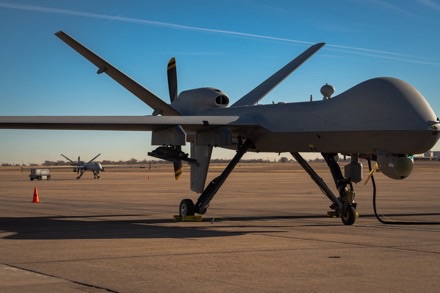
CANNON AIR FORCE BASE, N.M. —
The 27th Special Operation Wing’s Remotely Piloted Aircraft (RPA) community and industry partners completed several capability demonstrations throughout December 2023 as part of Air Force Special Operations Command’s Adaptive Airborne Enterprise (A2E) development.
As directed in the 2022 U.S. National Defense Strategy, AFSOC has shifted its priority from Counter-Violent Extremist Organization operations to also being capable of countering near-peer and peer adversaries in contested or denied environments. A2E is a result of that shift, marking an evolution beyond using the MQ-9 exclusively for Intelligence, Surveillance and Reconnaissance (ISR) and strike operations.

“Adaptive Airborne Enterprise is vital to thickening the Joint Force kill web throughout the spectrum of conflict and continues to be AFSOC’s #1 acquisition priority,” said Lt. Gen. Tony Bauernfeind, AFSOC commander. “Our Air Commandos are incredibly innovative, capable, and driven…they are bringing A2E to life. We will continuously develop the concept to full capability through multiple demonstrations over the next few years.”
A2E is broken into five phases, with the first three phases currently underway.
In phase one, AFSOC aims to transition to a government-owned Uncrewed Aircraft System (UAS) command and control interface, replacing the stationary RPA control system. The new A2E interface will shrink a traditional RPA crew’s deployed footprint and provide operators with the flexibility and mobility to fly various aircraft from austere locations – whether operating from the back of an AC-130, home station, or even urban environments.

“In the future, we’d like to take this from where we’ve fought in the past, a more permissive environment, to contested and denied spaces,” said U.S. Air Force Maj. Lindsay Scott, AFSOC Headquarters Rapid Capabilities Development Chief of Autonomous Capabilities. “Our goal is to ensure we are always bringing effects to the battle space.”
In phase two, AFSOC’s objective is creating the capability for a single crew to fly multiple MQ-9s. According to the director of the 27th Special Operations Group’s RPA Operations Center, U.S. Air Force Maj. Joshua Radford, AFSOC plans to evolve past the historical standard of one crew operating one aircraft, the status quo for MQ-9 operations.

“We’re moving towards a crew or a single operator controlling multiple aircraft,” Radford said. “And it doesn’t necessarily need to be the same platform.”
Phase three entails a single crew controlling multiple types of UASs, ranging from Group 1 small uncrewed aerial systems (sUAS) like the RQ-11B Raven, to larger Group 5 UASs like the MQ-9A Reaper.
In phase four, a single crew will control formations of UASs from mobile and austere locations, leading into the final phase: creating new effects-based ISR units. These units could be comprised of UASs, forward deployed ground forces, cyber operators and space operators that can collaboratively employ UAS capabilities in permissive, contested or denied environments.

The A2E demonstrations conducted in 2023 at Cannon AFB successfully validated many of the capabilities described in phases one through three. In June, the 27th SOW hosted Exercise Talon Spear, AFSOC’s first A2E sUAS collaboration exercise.
“The goal of Talon Spear was to build a continuous improvement exercise,” said U.S. Air Force Capt. Mitch, the exercise coordinator assigned to the 27th SOG. “Throughout the exercise, several industry and DOD partners integrated various systems, to include weapon systems, specific cameras, onboard computer systems and tactical situational awareness tools.”
During December’s demonstrations, a single 27th SOW RPA crew successfully exhibited two novel capabilities: controlling three MQ-9s utilizing a single common control interface and attaching and air-launching a Group 2 sUAS from an MQ-9A. The next A2E demonstration is planned for Summer 2024.
As the MQ-9 and its crews acquire the capability to direct sUASs carrying standoff sensor payloads, crews will be able to control swarms of air vehicles from anywhere. Additionally, AFSOC aims to continue developing and procuring A2E-compatible platforms, allowing the MQ-9 to act as a “mothership” for sUAS and loitering munition command and control, as well as a data transport node for mesh networks.
These mesh networks, in concert with Artificial Intelligence technologies and an advanced Human Machine Interface, will allow AFSOC crews to operate multiple large and small UASs simultaneously, covering more terrain and prosecuting more targets in environments that are not currently accessible.
“We depend on our innovative Air Commandos and industry experts to develop, experiment and grow this concept,” said Bauernfeind. “AFSOC is committed to advancing this capability and we appreciate the support of our defense partners and decision makers in prioritizing this acquisition.”
By collaboratively pathfinding alongside defense industry partners and innovative Air Commandos, A2E will transform the current AFSOC MQ-9 enterprise into the robust UAS architecture required to deliver specialized airpower to current and future fights: any place, anytime, anywhere.
By Senior Airman Alexcia Givens
27th Special Operations Wing Public Affairs

